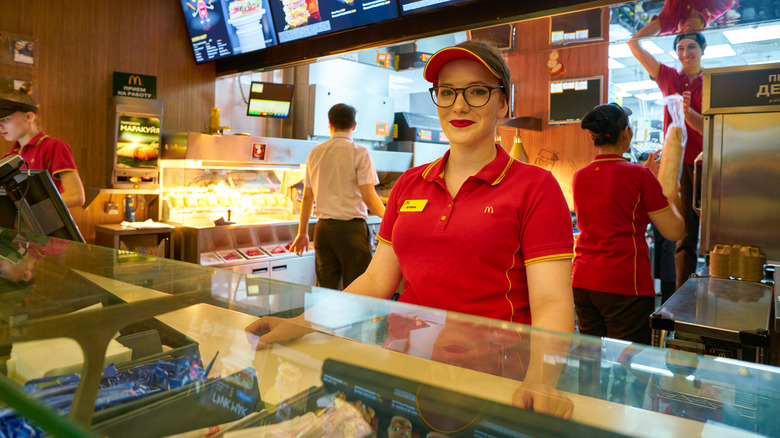Here's Why McDonald's Employees Don't Always Wear Gloves
Perhaps the best-known fast-food chain in the world, McDonald's is very meticulous about how its restaurants are run. This is especially true when it comes to glove use in its establishments, which McDonald's references on the FAQ page of its website. The chain has developed rigorous handwashing standards to ensure that the food it serves is safe for consumption. For example, employees who work in the dining area are required to wash their hands once per hour. As for the staff that handles food, they must wash their hands using an antibacterial cleanser once every half hour.
Some employees are required to wear gloves, typically when dealing with raw items. In this case, the chain has established a color-coding glove system to reduce the risk of foodborne illness even further. While it might seem like gloves offer the most substantial protection against germs and bacteria, proper handwashing is actually far more effective at protecting diners, hence why employees don't always have to wear gloves.
How handwashing reduces the risk of illness
According to the Centers for Disease Control and Prevention, nine in ten bouts of foodborne illness in dining establishments can be attributed to the presence of germs on the hands of restaurant staff. That's why establishments are encouraged to implement training programs providing information on the proper handwashing technique, as well as how often staff members should stop to wash their hands during the day.
When it comes to proper handwashing techniques, the CDC urges all restaurant personnel to follow certain methods. The first step is to rinse hands with running water, which should be followed up with soap. Next, the worker must scrub their hands with soap for 20 seconds or longer. All areas of the hands must be cleaned thoroughly. Once 20 seconds have transpired, hands can be rinsed and dried.
These practices are crucial for preventing germs and bacteria from being spread around restaurants, which ensures customers are fully satisfied with the dining experience. Proper handwashing can also overcome some of the worrisome elements of wearing gloves in a food service environment.
Why gloves can be problematic in dining establishments
The presence of gloves might be reassuring to fast-food customers, but they're not always the best way to uphold food safety. Take this Reddit thread, which discusses glove use in dining establishments, for example. As stated by one commenter, gloves provide "a false sense of cleanliness," as they can be an obstacle to frequent handwashing. For instance, a worker may feel that handwashing is not necessary since they're wearing gloves. This can result in germs being transferred from one place to another due to contaminated gloves.
Gloves can be beneficial in some instances, such as when an employee preparing food for a customer has a wound on their hand, as the glove will create a physical barrier. However, staff must change their gloves regularly, while also following pertinent rules related to handwashing. As for changing gloves, staff are encouraged to switch to a new pair when transitioning from one raw ingredient to another, after using the restroom facilities, or after coming in contact with known allergens (such as nuts or shellfish). Restaurant personnel should also change any gloves that have been worn for two hours or longer. These steps ensure a clean environment and maximum efficiency, which are two integral aspects of a quality fast-food chain.


